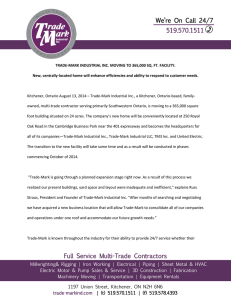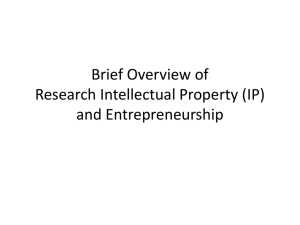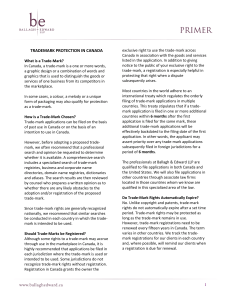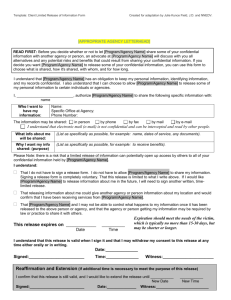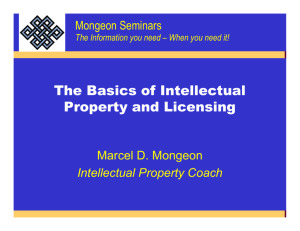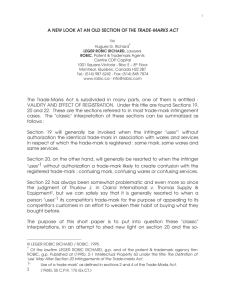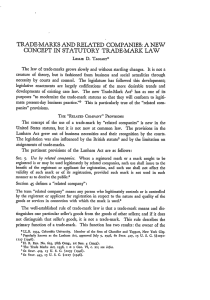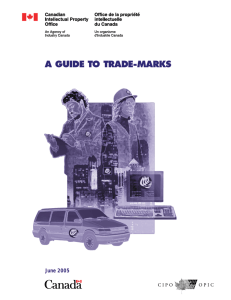law
advertisement
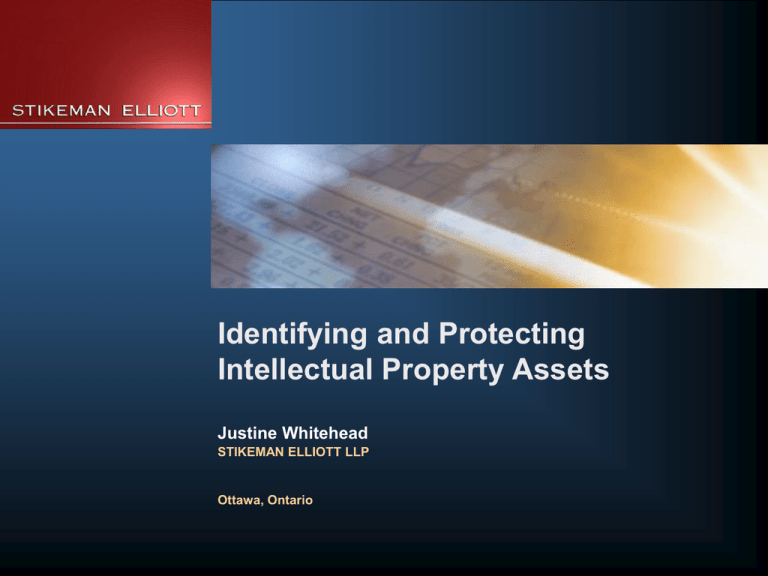
Identifying and Protecting Intellectual Property Assets Justine Whitehead STIKEMAN ELLIOTT LLP Ottawa, Ontario What is “intellectual property”? Certain creations of the mind can be considered “property”, because legal means exist to allow owners to exclude others from using the property Intellectual property (IP) is an intangible asset IP is protected to encourage creators, but public interest is also balanced in the statutory schemes 2 Why should you care about intellectual property? IP issues arise for employees and for entrepreneurs Often a major portion of a company’s assets consist of registered and unregistered intellectual property Identifying and protecting IP adds value to business Issues involving the identification and protection of IP arise in a number of contexts: – Creation – Registration or other protection 3 What is confidential information? There is no statutory or commonly accepted definition: confidential information / proprietary information / trade secrets often used interchangeably Confidential information is information which is not in the public domain and which provides the owner with a business advantage If a product can be reverse engineered, its make-up generally can not be considered confidential 4 “Hard Work” or “Springboard” Secrets Absolute secrecy not always required Publicly available information that requires expenditure of time and effort to compile can be protected: – Calgary Winter Olympics site case (Pharand Ski Corp. v. Alberta (1991), 37 C.P.R. (3d) 288 (Alta Q.C.) – Clamato case (Cadbury Schweppes Inc. v. FBI Foods Ltd.) [1999] 1 S.C.R. 142 Liability may be limited to value of head start and defendant may not be precluded from future use 5 How is confidential information protected? Before disclosure – Ensure adequate physical security measures taken – Monitor relevant publications/speeches by employees – Watch out for “dumpster diving” – Carefully consider and define the confidential information to be disclosed when executing non-disclosure agreements 6 How is confidential information protected? Common law rights of action Breach of contractual terms, whether express or implied Breach of confidence Breach of fiduciary duty 7 Action for Breach of Confidence To establish a breach of confidence, three elements must be shown: – The information itself must have the necessary quality of confidence about it; – That information must have been imparted in circumstances importing an obligation of confidence; and – There must be an unauthorized use of that information by one party to the detriment of the party whom the confidential information belongs 8 Ownership of confidential information If an employee creates valuable confidential information, who owns it? – Courts generally presume employee owns, unless: Express contract to the contrary Individual hired for purpose of inventing, or Individual is a fiduciary and thus has a higher duty of good faith towards the company 9 Is everything an employee knows confidential information? – A company can protect objective knowledge (e.g. trade secrets or formulae) – A company cannot stop a former employee from using his or her subjective knowledge (e.g. the skills and aptitudes that are transferable from job to job) – Often not easy to distinguish between the two 10 Patents - Introduction A patent is a statutory monopoly granted under the Patent Act for inventions Patents typically have a term of 20 years The monopoly grants the right to exclude other from making, using or selling the invention 11 12 What is protected? Each patent application (“specification”) contains two distinct parts – disclosure and claims Patent protection is afforded to the claims as set forth in the patent registration Each individual claim is, in effect, a separate and distinct monopoly awarded to the inventor 13 What is the test for patentability? Novel – Watch out for public disclosure and prior art Non-Obvious – An objective test using “person skilled in the art” Useful – Invention must work 14 Ownership of Inventions Inventor [the person who first independently thought of the invention and objectively manifested the idea] Employee Independent Contractor 15 Industrial Designs Industrial Design Act grants a statutory monopoly to protect the esthetic aspects of a manufactured article Term of 10 years from date of registration Exclusive right to make, use and sell items embodying the design 16 17 Copyright - Introduction What is “copyright”? – A property right in certain types of works, such as literary, artistic and musical works – Copyright is separate from the rights in the tangible creation – Copyright owner has the exclusive right to produce or reproduce the work or any substantial part thereof in any material form whatever What is “original”? – Creative spark not necessary, but need more than mere “sweat of the brow” – an original work is the result of an exercise of skill and judgment in the production of that work 18 What is protected? Copyright protects the particular expression of an idea, and not the idea itself What can be a “work”? – Literary, dramatic, musical or artistic endeavours – Computer software, tables are considered literary work – Protection extends to almost anything written, composed, drawn or shaped including commercial advertisements, jingles, company logos Work created outside Canada may be protected by copyright in Canada if the author was a citizen of or ordinary resident in a country that is a WTO member or that is a signatory to the Berne Convention or the Universal Copyright Convention 19 Who owns copyright? Usually the author of the original work But if an employee creates a work in the course of employment, that work belongs to the employer An assignment of copyright must be in writing When the author is the owner of the work, an assignment is effective only for the life of the author plus 25 years, after which the copyright reverts to the author’s estate 20 What are moral rights? Right of integrity Infringed where work, on an objective basis, is distorted, mutilated, or otherwise modified to the prejudice of the honour or reputation of the author Right of paternity Where reasonable in circumstances, to be associated with the work as its author, by name or pseudonym, or to remain anonymous Moral rights non-assignable, but subsist for the same term as other copyright rights – Moral rights can (and should) be waived in any copyright assignment 21 How long do copyrights subsist? Generally, for the life of author plus 50 years Some exceptions (e.g. photographs) 22 Trademarks - Introduction 23 Trade-mark/Trade Indicia What is a “trade-mark”? – A trade-mark is a word, logo, phrase (or any combination thereof) – A trade-mark identifies the source or origin of products and services and distinguishes one merchant’s offerings from those of its competitors 24 How do trade-mark rights arise? Trade-mark rights are created by “using” the trademark, and maintained by continuing its “use” “Use” for goods Appear on the goods (wrappers, labels, packaging), or brought to attention of consumer another way At the time of sale In the normal course of trade “Use” for services Appears in advertising relating to the services 25 How are trade-marks protected? A trade-mark registration lasts 15 years and is renewable in perpetuity A registration gives an owner the right to the exclusive use of the trade-mark throughout Canada in association with the goods/services for which it is registered Common law trade-mark rights support tort of passing off. To be successful, a plaintiff must show: – Reputation, or goodwill, acquired in the market place and attached to the goods/services provided in association with the mark; – Misrepresentation by the defendant causing confusion as to the source of the product; and – Actual or potential damage to the plaintiff due to the defendant’s conduct. 26 Benefits of Registration Registration grants right to exclusive use throughout Canada, even if the trade-mark is not actually used throughout Canada Registration can also allow the owner to defend itself against a third party trade-mark infringement claim, if the owner is sued for using its mark as registered 27 Benefits of Registration – Access to Statutory Rights of Action Imitation (section 19) YOPLAIT for yogurt vs. YOPLAIT for yogurt Confusion (section 20) YOPLAIT for yogurt vs. YOUPLAY for yogurt or YOPLAIT for butter Depreciation of goodwill (section 22) GOODTIME cars: all the quality of a FERRARI, without the exorbitant price! 28 Who owns the trade-mark? The entity that uses the trade-mark to distinguish its goods and services from others owns the trademark right If one can prove prior use of a mark or a confusingly similar mark, ownership can be challenged There can be instances of conflict between trademark rights and copyright rights (if a contractor designs a logo for you, make sure you get the copyrights to the logo assigned to you in writing) 29 What is the difference between a trademark and a trade name? Trade name: the name under which any business is carried on, whether or not it is the name of a corporation, a partnership or an individual A trade name is used for the purpose of distinguishing the owner’s business (not necessarily its goods and services) from the businesses of others Corporate name registration does not automatically entitle a company to use its name as a trade-mark 30 What is the difference between a domain name and a trade-mark? Domain names identify website addresses of businesses Domain names are more user-friendly than having to enter a number-based IP (Internet Protocol) address A trade-mark owner can stop others from using the same or a confusingly similar trade-mark as part of a domain name for a competitive product or service, if such use is likely to cause confusion in the minds of the public about the source of the goods/services 31 Justine Whitehead Tel: (613) 566-0541 jwhitehead@stikeman.com www.stikeman.com

